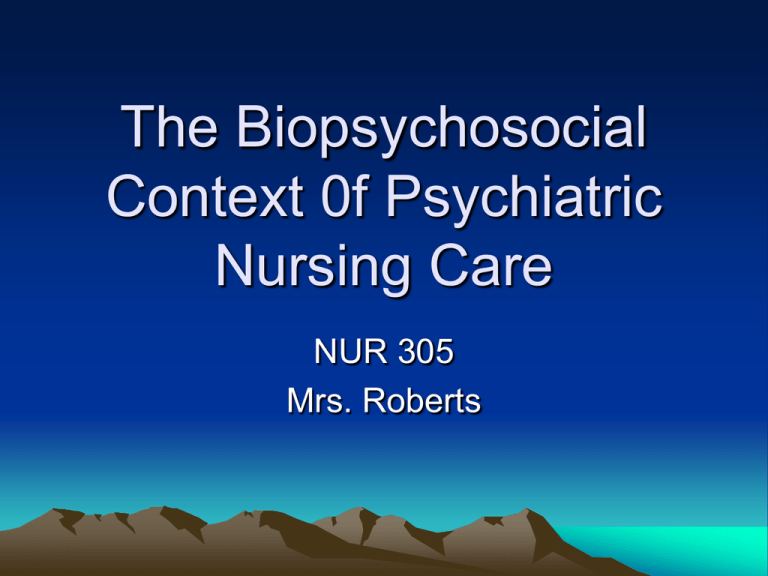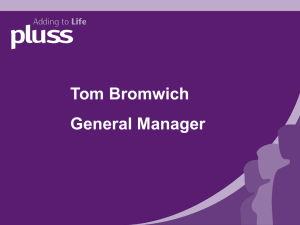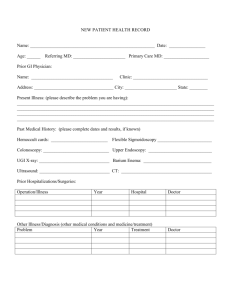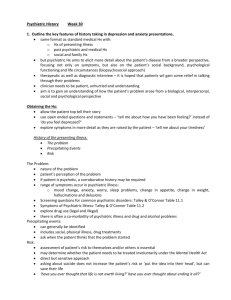Biopsychosocial Context 0f Psychiatric Nursing Care
advertisement

The Biopsychosocial Context 0f Psychiatric Nursing Care NUR 305 Mrs. Roberts Bio context-the brain The Cerebrum- conscious perception, abstract reasoning, and thinking 4 lobes: Frontal-speech & motor function Temporal-auditory processing & language Parietal-sensory function Occipital-visual function The brain cont. • The cerebellumequilibrium, muscle tone, balance, posture. Limbic system • Forms the border of temporal lobes • Associated with emotional subjective states, “fight or flight” reactions, and memory. Brain cont. • Thalamus – influences mood and affect • Hypothalamustemperature regulation, endocrine function, feeding & drinking behavior Brain cont. • Brainstem • Pons-reflex center • Medulla-breathing, HR, swallowing, • Reticular formationcore of brainsteminvolved with consciousness & the sleep-wake cycle. Neurotransmission • Process by which neurons communicate with each other through electrical impulses and chemical messengers. • We all have about 100 billion brain cells. Neurotransmitters • Are released from the axon into the synapse, then received by the dendrite of the next neuron. Neurotransmitters cont. • Serotonin-5HT ( 5 hydroxytryptophan) derived from a dietary amino acid. Located only in the brainstem. Plays a role in mood and activities of the CNS. Plays a role in anxiety disorders. Antidepressants block its uptake. Neuroimaging techniques Measure activity, function, and blood flow & allow for visualization of the brain CT- computed tomography MRI- magnetic resonance imaging PET-positron emission tomography SPECT-single photon emission computed tomography Biological rhythm • Circadian rhythm- is a network of internal clocks in the body that work according to a 24-hour cycle. • Sunlight is the time cue from the external environment that resets our “clock.” • The hypothalamus is the “internal timekeeper.” Sleep • 5 stages: • Stage 1-”falling asleep” • Stage 2- sleep itself • Stages 3 & 4- “delta sleep” or deep sleep • Stage 5- REM sleep occupies 25% of sleep time Psychoneuroimmunology • Explores the interactions between the CNS & the endocrine, and immune system. • Research indicates increased susceptibility to illness following sleep deprivation, depression, and death of a spouse. • Also NK (natural killer) cells decrease in # with increased levels of stress. Genetics • The search for genes that cause mental illness has been inconclusive but has stimulated scientific, political, and clinical debate. • Currently based on studies based on inheritance such as family, twin, & adoption studies. Proposed uses of genetics in psychiatry • Developing new drugs that will target molecular regulators of gene expressions in brain regions shown to be abnormal in a psychiatric illness. • Conducting gene therapy to treat psychiatric illness. • Implementing studies that use cloned genes in research procedures in psychiatry. Biological assessment of the patient • Includes: • Screening patients for the major signs of physical or organic disorders that may complicate a patient’s psychiatric status. • A complete health care history and lifestyle review • Physical exam & labs Psychological context of psychiatric nursing care • The Mental Status Exam-nurse’s observation of the patient’s current state; not past or present state. Content of the mental status exam • • • • • • • • • Appearance Speech Motor Activity Interaction during interview Mood- pt’s self report of emotional state Affect-emotional tone Perceptions Thought processes Memory & Judgment Psychological tests • 2 types; • Evaluation of intellectual & cognitive ability ( i.e.. WAIS,WISC) • Evaluation of personality functioning (projective tests) Personality tests • Rorschach test • Thematic Apperception Test • (TAT) • Minnesota Multiphasic Personality Inventory (MMPI) Thematic Apperception Test • Person tells a story about a series of pictures. • What has led up to the event. • What’s happening at the moment. • What the characters are feeling. • What the outcome is. Behavioral rating scales • Standardized scale • Gather a number of measurable behavioral indicators of the patients adaptive and maladaptive responses. Cultural competence • Implies cultural awareness. • The ability to view each patient as a unique individual. Functions of culture • Creates a perception of reality • Motives for behavior • Identity • Values • Communication • Emotions Sociocultural risk factors & protective factors • • • • • • Age Ethnicity Gender Education Income Beliefs Gender • Being female can increase the risk of depression in women. • Being male is associated with increased risk of suicide. Age • Depressed elderly patients tend to recover more quickly than younger age groups. Ethnicity • Includes a person’s racial, tribal, linguistic, and cultural origin or background. • Each cultural group has its own custom, beliefs, and traditions. • Influences the development and recovery from psychiatric disorders. Research on ethnicity • Members of ethnic groups are admitted to psychiatric institutions 3 times more than the general population (Shin 2002) • Asians have low admission to rates to state hospitals. Research cont. • Members of minorities have difficulty gaining access to mental health services. (Hough et al.,2002,) • Latino youths are less likely than white youths to use specialty mental health services. Education • Education is more important than income in determining the use of mental health services. Patients with less education are less likely to seek psychiatric care and are more at risk for dropping out of treatment. Income • The impact of all other risk factors are multiplied by poverty. • Higher prevalence of poverty rates are consistently found among women, the elderly, and ethnic and racial minorities. (Alegria, 2002) Questions to facilitate cultural competency “What labels am I subconsciously applying to this patient and how did I learn them?” “What socioeconomic status am I assuming for the patient, and what are my assumptions about that socioeconomic level?” “What other explanations might account for the patient’s behavior.” Sociocultural Stressors • Disadvantagement: the lack of socioeconomic resources that are basic to biopsychosocial adaptation. • Stereotype: a depersonalized conception of individuals within in group. • Discrimination: differential treatment of individuals not based on actual merit. • Racism: the belief that inherent differences among races determine individual achievement and than one race is superior. Therapeutic nurse-patient interactions • Sociocultural differences can be a source of misunderstanding by the nurse and resistance by the patient. • Healthy recognition of nurse-patient sociocultural differences can enrich the health care experience for both the nurse and the patient.





